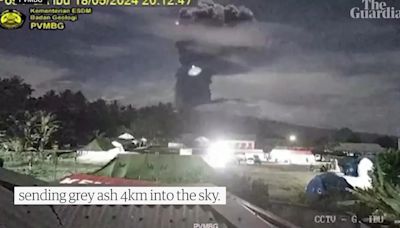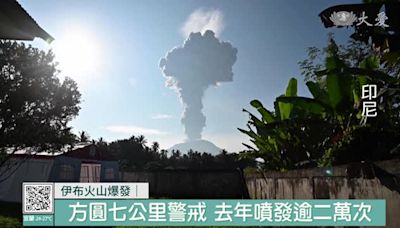搜尋結果
Tsunami waves of 1–2.5 m (3 ft 3 in – 8 ft 2 in) were observed in several islands in Vanuatu. The Vanuatu Meteorology and Geo-hazards Department said tsunami activity was expected to persist for the night of 15 January 2022. [96] Waves up to 0.8 m (2 ft 7 in) in height were recorded in Hanalei, Hawaii.
- 15 January 2022
- Hunga Tonga–Hunga Haʻapai
- 20 December 2021
- Build-Up and Evacuations
- Escalation of Eruption
- Effects on Aircraft
- Aftermath
- In Popular Culture
- Further Reading
On July 16, 1990, a magnitude 7.7 earthquake struck northern Central Luzon and the Cordilleras. This was the largest earthquake recorded in 1990, comparable in size to the 1906 San Francisco earthquake and the 2008 Sichuan earthquake. Its epicenter was in the municipality of Rizal, Nueva Ecija, about 100 km (62 mi) northeast of Pinatubo, and faulte...
A small blast at 03:41 PST on June 12 marked the beginning of a new, more violent phase of the eruption. A few hours later the same day, massive blasts lasting about half an hour generated big eruption columns, which quickly reached heights of over 19 kilometres (62,000 ft) and which generated large pyroclastic surges extending up to four kilometre...
At least 16 commercial aircraft had damaging in-flight encounters with the ash cloud ejected by the June 15 eruption, and many grounded aircraft were also significantly damaged. In-flight encounters caused loss of power to one engine on each of the two aircraft. Ten engines were damaged and replaced, including all three engines of one DC-10. Longer...
Explosivity of the eruption
The 1991 eruption rated 6 on the Volcanic Explosivity Index and came some 450–500 years after the volcano's last known eruptive activity. The eruption ejected about 10 km3 (2.4 cu mi) of material, making it the largest eruption of the 20th century since that of Novarupta in 1912 and some ten times larger than the 1980 eruption of Mount St. Helens. Ejected material such as tephra fallout and pyroclastic flow deposits are much less dense than magma, and the volume of ejected material was equiva...
Death toll
A reported 847 people were killed by the eruption, mostly by roofs collapsing under a load of accumulated volcanic matter, a hazard amplified by the simultaneous arrival of Typhoon Yunya. The evacuation in the days before the eruption certainly saved tens of thousands of lives, and has been hailed as a great success for volcanology and eruption prediction. After the eruption, about 500,000 people continue to live within 40 km (25 mi) of the volcano, with population centers including the 150,0...
Effects on agriculture
Many reforestation projects were destroyed in the eruption, with a total area of 150 km2 (58 sq mi; 37,000 acres) valued at 125 million pesos destroyed. Agriculture was heavily disrupted, with 800 km2 (310 sq mi; 200,000 acres) of rice-growing farmland destroyed, and almost 800,000 head of livestock and poultrykilled, destroying the livelihoods of thousands of farmers. The cost to agriculture of eruption effects was estimated to be 1.5 billion pesos. Many farmers near Pinatubo began growing q...
The eruption is featured in volcano and disaster documentaries: 1. Nova: "In the Path of a Killer Volcano" (PBS, 1993) 2. Volcano: Nature's Inferno (National Geographic, 1997) 3. Pinoy True Stories: Red Alert (ABS-CBN, 2014–15) 4. Earth's Fury (Anatomy of Disaster in the United States): "Volcano" (GRB Studios, 1997) 5. Mega Disaster (NHNZ, 2006) 6....
Gaillard, Jean-Christophe (December 2006). "Was it a cultural disaster? Aeta resilience following the 1991 Mt Pinatubo eruption". Philippine Quarterly of Culture and Society. 34 (4): 376–399. JSTOR...
- September 2, 1991
- Mount Pinatubo
- April 2, 1991
Mount Tambora is a volcano on the island of Sumbawa in present-day Indonesia, then part of the Dutch East Indies, [2] and its 1815 eruption was the most powerful volcanic eruption in recorded human history. This volcanic explosivity index (VEI) 7 eruption ejected 37–45 km 3 (8.9–10.8 cubic miles) of dense-rock equivalent (DRE) material into ...
- 15 July 1815
- Ultra-Plinian
- 1812
- Mount Tambora
Eruption dating. The Minoan eruption is an important marker horizon for the Bronze Age chronology of the Eastern Mediterranean realm. It provides a fixed point for aligning the entire chronology of the second millennium BCE in the Aegean, as evidence of the eruption is found throughout the region.
- c. 1600 BCE
- Ultra Plinian
- 7
- Thera
Lithograph of the eruption c. 1888. The 1883 eruption of Krakatoa ( Indonesian: Letusan Krakatau 1883) in the Sunda Strait occurred from 20 May until 21 October 1883, peaking in the late morning hours of 27 August when over 70% of the island of Krakatoa and its surrounding archipelago were destroyed as it collapsed into a caldera .
- 36,417–120,000
- 20 May 1883
- 21 October 1883 (?)
- Krakatoa
Lake Taupō, in the centre of New Zealand's North Island, fills the caldera of the Taupō Volcano, a large rhyolitic supervolcano.This huge volcano has produced two of the world's most powerful eruptions in geologically recent times.The volcano is in the Taupō Volcanic Zone within the Taupō Rift, a region of rift volcanic activity that extends from Ruapehu in the south, through the Taupō ...
A volcano is a rupture in the crust of a planetary-mass object, such as Earth, that allows hot lava, volcanic ash, and gases to escape from a magma chamber below the surface. On Earth, volcanoes are most often found where tectonic plates are diverging or converging, and because most of Earth's plate boundaries are underwater, most volcanoes are ...





